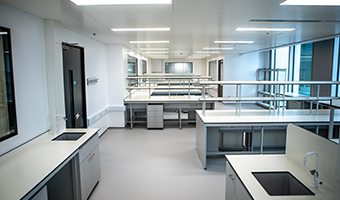LSH’s third annual office occupier survey records a continued upward trend in office attendance. However, large companies have the lowest attendance rates and are also most likely to be considering office relocations.
Download the Thames Valley and South East report in full here
OCCUPANCY TICKS UP
The results from our latest survey show a moderate increase in office attendance over the past year, with three days a week becoming further entrenched as the most common turnout level. When asked to estimate the average number of days per week that staff in their organisations spent in the office, 45% said three days, up from 39% in 2023.
The survey answers imply average office attendance of 3.1 days a week, up from 2.8 days last year. This can be attributed to an increased number of staff coming to the office on the quieter days of Monday and Friday. 28% of survey respondents reported typical attendance levels of either four or five days a week, compared with 22% last year. Attendance levels of two or fewer days a week have declined, but still remain the norm in over a quarter (26%) of respondents’ organisations.
"45% SAID OFFICE ATTENDANCE OF THREE DAYS A WEEK IS NOW THE NORM"
The survey results show some variations in attendance rates between sectors. Three office days a week is particularly common among those from Banking & Insurance (71%) and Professional Services (69%). Lower levels of attendance are evident among Public Sector respondents, 55% of whom said that two or fewer days a week was still normal.
SMALLER THE BETTER
Variations in attendance levels are particularly evident when comparing organisations of differing size. Smaller companies’ employees spend significantly more time in the office than those working for larger firms. Among those with fewer than 50 employees, 45% reported office attendance of five days a week, compared with less than 10% in all other size-bands.

The larger the firm, the more likely it is that staff will attend the office three days a week; this was reported by 50% of those working for organisations with 200-999 staff, and 67% in firms with 1,000-plus staff. Fuller office attendance remains a rarity in bigger firms, with only 7% in the largest size-band saying that four or more days was typical.
Disparities in attendance levels reflect fundamental differences between the needs of smaller and larger firms, with offices seen as essential to the day-to-day operations of many small businesses. Larger companies are more likely to have the necessary infrastructure to support hybrid working, while also employing staff who live across wider geographic areas, making the daily commute less appealing.
MOST ARE NOW SATISFIED
Most survey respondents are content with current attendance levels, with 65% saying that they are satisfied with, or accepting of, them. However, in firms where two days a week is typical, a majority (56%) reported being dissatisfied. Predictably, the rate of satisfaction increases with attendance, rising above 80% in firms where four or more days is typical.
More than three quarters (78%) of respondents said that their organisations had taken actions to guide or stipulate minimum levels of staff attendance, although the degree of intervention varies. Only 6% said that the aim of such policies was restoring attendance to the pre-pandemic norm; 37% said that they allowed for a degree of hybrid working; while 35% said that significant elements of hybrid working were accommodated.
"78% OF ORGANISATIONS HAVE TAKEN ACTIONS TO GUIDE OR STIPULATE ATTENDANCE LEVELS"
Of the 22% of respondents who said that measures had not been taken to guide minimum attendance, most were in smaller firms where office turnout is higher anyway, without the need for formal actions.
CHANGING NEEDS
The extent to which workspaces have changed over the last five years varies widely across the occupiers in the survey. Respondents were fairly evenly split between those who said there had been no clear change (37%), those reporting that their organisations had relocated some or part of their operations into different offices (35%), and those saying that existing workspace had been re-configured to accommodate changing work patterns (29%).
"41% HAVE REDUCED THEIR OCCUPATION OF OFFICE SPACE OVER THE LAST FIVE YEARS"
Less than half of those surveyed (41%) said that their organisations had reduced their occupation of office space compared with five years ago, while 37% said that their volume of space was broadly unchanged. In contrast, 22% said that they had taken more space to accommodate increased headcounts, with nearly all of these being at firms with fewer than 200 employees.
However, the occupation trends of the largest companies in the survey differ greatly from all other organisations. While 76% of those in the sub-1,000 staff size-bands reported that they now occupied either the same or more space compared with five years ago, 80% in the 1,000-plus employees category said that their space had reduced.
Among those that have decreased their office occupation, the most common reduction in space was c. 20%. This was cited by 40% of all respondents employed by companies with 1,000-plus staff, while a third (33%) in this size-band mentioned larger space losses of 30% or more.
LARGE FIRMS STILL MOVING
The majority of organisations in the survey are happy with the amount of space they currently occupy, with 67% saying that it was appropriate for their current needs. Those less satisfied with their offices include 24% saying they still had more space than needed; while 8% said that in hindsight too much space had been cut in recent years.
Reflecting relative satisfaction with current space levels, 53% said that their organisations are not considering moving operations to different offices in the short-to-medium term. However, 22% said that they are seeking moves to less space, 6% are looking to relocate to roughly the same amount, while 18% are considering taking more space.
Smaller organisations are least likely to be seeking office relocations, with 82% in the sub-50 staff size-band not considering moves. Around half of firms in the middle size-bands (50-199 and 200-999 staff) are also not contemplating office moves and, among those who are, they are almost as equally likely to be looking for a space increase as a reduction.
Larger companies with 1,000-plus staff are the most inclined to be considering moves, both of a contractionary and expansionary nature. In this size-band, 40% are seeking less space, while 27% are looking for more.
71% of those surveyed said that cost savings were either not a motivating factor, or only a secondary consideration, when making location decisions. Only 29% said that cost saving was, or will be, a key motivating factor when seeking to occupy less space. However, cost savings are a greater motivation for larger companies, 47% of whom said this was a key consideration.
CORPORATES DRIVING CHANGE
While the improvement in office attendance levels recorded by this year’s survey is less dramatic than the one seen last year, a clear upward trend has continued. Nonetheless, hybrid working is here to stay, and three office days a week appears to be engrained as the dominant attendance pattern in many firms.
However, the starkest trend seen in this year’s survey is the variance between the answers of respondents working for large companies and those from small and midsized firms. While most smaller companies have higher office attendance and are relatively content with their current office occupation, larger firms remain restless as they further refine hybrid working policies and space strategies. Office market activity will continue to be driven by major corporate occupiers adjusting their requirements in the ongoing search for the optimal balance between the size, quality and cost of space.
"40% OF LARGE OCCUPIERS ARE CONSIDERING MOVES TO LESS SPACE; BUT 27% ARE SEEKING MORE SPACE"
Many of those surveyed have already made decisions to reduce their occupation of office space, but the exchange of quantity for quality is an ongoing process. Given that large occupiers are most inclined to consider relocations to less space, the survey results imply an overall reduction in office requirements of c. 10% across all respondents’ organisations. Over time, this points to the accelerated obsolescence of poorer quality offices, much of which will be gradually filtered out of the market via change of use opportunities.
Download the Thames Valley and South East report in full here
ABOUT THE SURVEY:
Conducted in May 2024, LSH’s office occupier survey provides a snapshot of attendance levels, attitudes to hybrid working and the ongoing impact of shifting work patterns on companies’ space requirements.
This year’s survey builds on those of the last two years, to assess how much has changed now that the pandemic is firmly in the rear-view mirror.
The survey received responses from key occupier clients of LSH representing businesses with a total of more than 150,000 UK staff. Organisations included in the survey range from small companies with fewer than 50 staff to global corporate occupiers with thousands of employees spread across multiple sites nationwide.
A wide range of sectors are represented in the survey, including professional services, TMT, banking & insurance and the public sector. The biggest single occupier group was professional services, which accounted for 27% of the responses
Get in touch

Email me direct
To:
REGISTER FOR UPDATES
Get the latest insight, event invites and commercial properties by email









